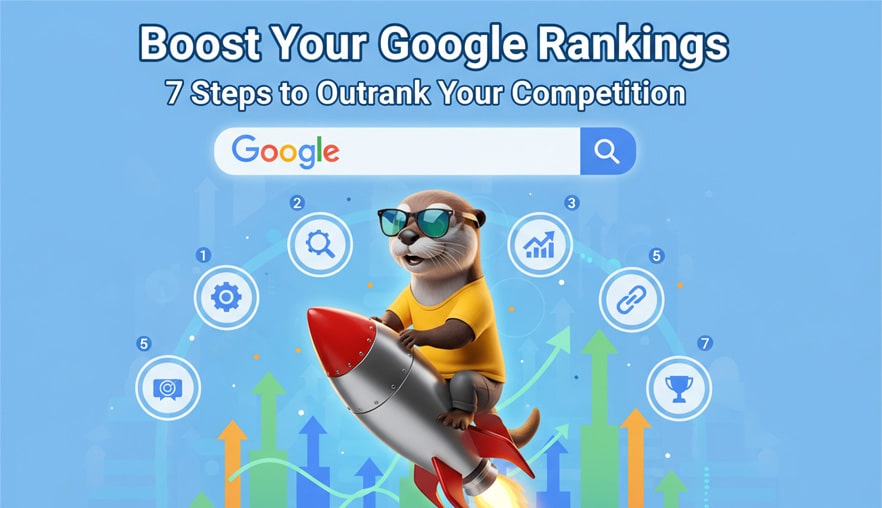In the crowded digital landscape, securing a top spot on Google is the ultimate goal for any business. But with competition constantly fierce, simply having a website is no longer enough. To truly dominate the search engine results pages (SERPs) and attract valuable organic traffic, you need a strategic approach that goes beyond basic SEO.
This guide reveals seven steps your digital marketing agency can follow to help your clients not just compete, but completely outrank their rivals on Google.
Step 1: Conduct a deep-dive competitive analysis
Before you can beat the competition, you need to understand them. A deep-dive competitor analysis involves more than just seeing who ranks for your target keywords. It’s about uncovering their entire strategy.
- Identify top competitors: Use tools like SEMrush or Ahrefs to find the primary organic competitors for your target keywords.
- Analyze their content: What topics are they covering? What content formats are they using (e.g., listicles, how-to guides, videos)? Look for content gaps that you can fill with better, more comprehensive content.
- Audit their backlink profile: Where are their links coming from? Which pages receive the most links? This reveals potential link-building opportunities for your own site.
Step 2: Master keyword research and search intent
Keywords are the foundation of SEO, but simply targeting high-volume terms is a mistake. The key is to understand user intent—the reason behind a search query.
- Go beyond head terms: While “digital marketing” is a broad term, long-tail keywords like “digital marketing strategies for small businesses” have lower competition and higher conversion potential.
- Match intent with content: Analyze the current SERP for your keywords. If Google is showing product pages, don’t write a blog post. If it shows listicles, create one that’s better.
- Optimize for AI Overviews: As AI integrates further into search, create unique, high-quality, and helpful content that directly answers user questions. Focus on demonstrating experience, expertise, authoritativeness, and trustworthiness (E-E-A-T).
Step 3: Create superior, helpful content
Google rewards sites that provide genuine value. To outrank your rivals, your content must be 10x better. This doesn’t just mean longer; it means more comprehensive, trustworthy, and engaging.
- Answer questions thoroughly: Cover topics from multiple angles, providing insights and details that your competitors missed.
- Feature expert authors: To build E-E-A-T, use bylines with real-world experience. Credible authors increase the trust signals Google perceives.
- Refresh old content: Don’t let your old posts decay. Update outdated statistics, add fresh links, and expand sections to maintain relevance.
Step 4: Strengthen your backlink profile
Backlinks are still one of the most important ranking factors. They act as “votes” from other websites, signaling to Google that your site is a credible and valuable resource.
- Earn, don’t buy: Focus on earning high-quality, natural backlinks from authoritative sites in your industry. Avoid spammy link schemes that can harm your reputation.
- Utilize the Skyscraper Technique: Find popular, well-linked content from a competitor. Create a significantly better version on your site, then reach out to the websites linking to the original content.
- Use Digital PR: Create shareable, data-driven content like original research reports or infographics. This makes your brand a go-to source for journalists and bloggers, attracting links and press mentions.
Step 5: Master on-page and technical SEO
While content and backlinks are crucial, a technically sound and well-optimized website is the foundation of any successful SEO strategy.
- Optimize for keywords: Strategically place your target keywords in key areas, including title tags, meta descriptions, headers (H1, H2), and image alt text.
- Improve site speed: A slow website frustrates users and hurts rankings. Compress images, minify code, and ensure your hosting is fast.
- Ensure mobile-friendliness: With Google’s mobile-first indexing, your site must be responsive and provide a seamless experience on all devices.
- Use schema markup: Implement structured data to help search engines understand your content better. This can help you get rich snippets that stand out in SERPs.
Step 6: Leverage local SEO and reviews
For businesses with a local presence, dominating local search results is a key way to outrank the competition and drive in-store traffic.
- Optimize your Google Business Profile: Fill out every detail, including business hours, address, phone number, and category. Post regular updates and add high-quality photos.
- Get more customer reviews: Encourage satisfied customers to leave positive reviews on your Google Business Profile. Respond to all reviews, both positive and negative, to show you value feedback.
- Build local citations: Get listed in online directories relevant to your industry and location. This builds local credibility.
Step 7: Measure, track, and adapt
SEO is not a “set it and forget it” strategy. The algorithms and your competitors are constantly changing, so you need to be vigilant.
- Monitor your analytics: Use Google Analytics and Search Console to track keyword rankings, organic traffic, and conversions. Identify what’s working and what isn’t.
- Track competitor performance: Keep an eye on your rivals’ rankings and traffic. Tools like Semrush can provide data to help you stay ahead.
- Adapt your strategy: Based on your analytics and competitor insights, continuously refine your keyword strategy, update content, and fix technical issues to maintain your competitive edge.
By implementing these seven steps, you can create a robust and resilient SEO strategy that will help your clients not just boost their Google rankings, but truly outrank the competition for the long term.


